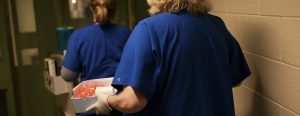IN BALTIMORE, MASS OVERDOSE A GRIM REMINDER OF THE COURSE OF A LETHAL, WORSENING OPIOID CRISIS UNDER EXPERT TREATMENT
With known risk of death from an unpredictable supply, indiscriminate, potentially lethal street drug use driven by untreated compulsions is the failure of gold standard treatments
by Clark Miller
Published July 18, 2025
What is most remarkable and ultimately disturbing about the MASS OVERDOSE in Baltimore is the shock effect of an entirely predictable and inevitable – albeit more acute and headline-grabbing – instance of what is g0ing on every day in every city in America. While deaths drop due entirely to intense, targeted, successful naloxone campaigns serving as desperate, emergency harm reduction, high-risk, indiscriminate opioid use is worsening. That, as we’ll see, is happening in Baltimore, where provision of America’s expert gold standard treatments has surged over past years, is happening in Columbus, Ohio, happening in Philadelphia, happening everywhere in America.
As should be evident, or will be, one of the most important takes on the event was this, from an abc News report –
“Before the city really embraced Naloxone, that would have been a devastating toll of people,” Catherine Tomko, assistant scientist with the Johns Hopkins School of Public Health said. “That’s really, really important to keep in mind.”
What about Baltimore?
It’s gotten a bad rep and has a history, number one in opioid overdose deaths, America’s overdose “capital”, for reasons explained here.
From an upcoming post (“FROM OPIOID CRISIS CAPITAL CITY BALTIMORE, MORE MEDICAL MISINFORMATION TO HIDE CAUSES OF RECORD DEATHS AND A WORSENING CRISIS”) –
And what about that naloxone campaign in Baltimore? In detail, in this post and this, the course of a dramatic shift to more intensive, targeted, community based, successful efforts – resulting in distribution, use, and reversal of many times more potentially fatal overdoses than are needed to fully account for all reductions in opioid deaths – corresponds exactly in a time line as antecedent and cause of the dramatic drop in fatal opioid overdoses seen in late 2023 and 2024. Timing, known prevention of deaths, and mortality data fitting in a causal relationship.
While in Maryland, despite Narcan moderation of fatal overdose by reducing harms of gold standard treatments, high-risk opioid use, measured by nonfatal overdoses, continued to mount, incontrovertably pointing to gold standard treatment failure.
And this from that upcoming post –
Let’s consider the evidence.
In Baltimore and in Maryland generally, the availabiity and provision of substitute opioids buprenorphine and methadone were rising dramatically as early as 2013 and 2014 for buprenorphine, with provision of methadone rising to 3rd highest in the nation by 2021 measured by per capita number of outpatient clinics, 4th highest in the nation for average daily dose to recipients by 2020. Those trends and timelines are covered in detail with supporting evidence and links to research and reports in past posts for Baltimore, here, and for Maryland, here.
Maryland then joined with other states to significantly relax prescribing safety standards for methadone and buprenorphine. From the previous post –
And this, from that “previous post” –
But bupe isn’t the only form of expert-assured, proven, “medication support” for problem opioid use.
There’s methadone.
And that’s where Maryland’s efforts based on guidance from the consensus of America’s top experts really stand out.
Here’s a graphic generated by the DEA and presented in this research paper, showing Maryland 3rd highest in the nation through 2021 in number of methadone outpatient programs per 1 million population.

And magnifying that effect, also from the DEA, average daily dose of methadone for those it is dispensed to was in 2020 4th highest for Maryland among all states.
The graphic is annotated by the author of the piece it appeared in, here.

That’s a high level of dispensing of methadone to individuals with history of high-risk use, completely in line with emerging expert consensus of “the more the better”, reflecting the push beginning around 2020 for relaxation of methadone safety standards, notably “take-home” rules.
And Maryland, among the top states for dispensing methadone, again complied with calls to loosen standards.

How has that worked out, relaxing safety standards for dispensing of methadone, like buprenorphine commonly abused with additional substances?
Consistently, locales that adopted relaxed standards and/or significant expansion in provision of methadone have experienced increased methadone-related deaths, described here for:
Ohio
Arizona
Colorado
Washington DC, and
Ontario, Canada
And in a post soon to appear, for Vermont.
That’s no surprise, based on what a longstanding body of evidence tells us about methadone.
Back to our current post –
And what about “miracle molecule” methadone?
Methadone, it turns out, is the “couple a beers to take the edge off” that gets followed by “okay, now how bout some shots?” medical cure, established as predicting abuse of illicit opioids and increased opioid overdose and deaths, covered here and here and here.
Sam Quinones laid it out in the true tale “Dreamland” a decade ago, its truths buried for almost that long. From a previous post –
Everywhere, Signs of a problem:
1) as public healthcare resources are increasingly devoted to a strategy of providing buprenorphine as a substitute addictive opioid, evidence mounts of failed effectiveness and of diverted “bupe” instead driving economies of abuse and
2) new powerful synthetic opioids hitting the street in an ever-evolving economy of addictive need seem to be neurochemically outcompeting, overwhelming presumed protective effects of the “anti-addiction” drug.
Signs enough for major media calls for a return to methadone – methadone, the more dangerous, more addictive substitute opioid that bupe replaced as a safer alternative – to become the new-old medical cure for the non-medical condition of compulsive substance use and for America’s worsening lethal, medically-generated opioid crisis.
Methadone!
Some observers – media writers – surveying America’s wasteland of uncontrolled epidemics, seem to glimpse dimly the writing on the wall: the clear indications of the endorsed-by-consensus, increasingly funded, medical substitute opioid fix failing as a treatment, or even as harm reduction, overdose deaths sharply rising the more fix is provided, that substitute opioid fix functioning instead as an integral product and currency in illicit economies of abuse and illness.
And surveying that grim landscape have begun casting about for an alternative to today’s gold standard, buprenorphine, for another medical fix (because problem opioid use like all problem substance use is, after all, a medical condition, a disease of the brain. Isn’t it?), generously offering the treatment recommendation of easing restrictions on and expanding provision of methadone, the substitute opioid replaced by bupe based on higher risk of abuse and overdose for methadone.
These writers wondering if it wouldn’t make sense to re-allocate, re-divert, public healthcare funds away from the failed Suboxone campaign and to methadone programs, more than that, to more relaxed and extensive provision of the addictive, abused opioid methadone, by relaxing federal guidelines and restrictions enacted to protect patient safety.
Methadone clinics
In Dreamland, Sam Quinones’ devastatingly unflinching indictment of American institutions and trusted medical and media authorities complicit in the lies generating the opioid crisis, methadone clinics are described as playing a crucial role in the wildly successful expansion of cheap, potent black tar heroin from Mexico into the U.S. – up the West Coast, into midwestern cities and everywhere in between – because those clinics are hubs for trade and use of illicit and licit drugs of abuse (p 64) –
Methadone clinics gave Xalisco Boys the footholds in the first western U.S. cities as they expanded beyond the San Fernando Valley in the early 1990s. Every new cell learned to find the methadone clinic and give away free samples to the addicts.
One Xalisco Boy in Portland told authorities of a training that his cell put new drivers through. They were taught, he said, to lurk near methadone clinics, spot an addict, and follow him. Then they’d tap him on the shoulder and ask directions to someplace. Then they’d then spit out a few balloons [packaged black tar heroin]. Along with the balloons, they’d give the addict a piece of paper with a phone number on it.
“Call us if we can help you out.”
The value of each Xalisco heroin tiendita was in its list of customers. “This is how they would build and maintain it,” said Steve Mygrant, a Portland-area prosecutor. “It was an ongoing recruiting practice, in the same way a corporate business would identify customers.
And in Indianapolis and Columbus, Ohio (pp 143-144) –
Camping out in front of the town’s methadone clinic, he gave away samples of his dope and soon had a client list of desperate junkies avid for the black tar they’d never seen before.
. . .
They met at the town’s methadone clinic off Bryden Road the next morning. The clinic was a hive of illegal dope trading. Almost anything a user wanted was for sale. He gave Chuckie a few free samples and his beeper number.
That afternoon, Chuckie called.
“That’s some killer stuff you got,” he said. “I gotta whole buncha people want some of that.”
Reporters glimpsing dimly the writing on the wall and missing, blinded to, the graffiti next to it. The signs and reports everywhere, of what should be obvious, signs of why bupe seemed, at least on a superficial and unexamined level, to make sense as a safer alternative to methadone. Methadone, highly regulated and dispensed in clinics, in Appalachia the gathering places for illicit trade and use of opioids and other drugs.
From Beth Macy’s Dopesick (pp 215, 218) –
“I’m walking around the methadone clinic parking lot for two hours with a four-day-old baby,” Patricia said. “And it was loaded with addicts. It was a place where Tess’s circle of addicts would become even bigger than it already was.”
. . .
As early as 1963, progressive researchers conceded that designing the perfect cure for addiction wasn’t scientifically possible, and that maintenance drugs would not “solve the addiction problem overnight,” considering the trenchant complexities of international drug trafficking and the psychosocial pain that for millennia has prompted many humans to crave the relief of drugs.
America’s opioid crisis has proven those progressive researchers wrong
– it’s not that maintenance drugs could not “solve the addiction problem overnight”, it’s that those drugs do not constitute treatment of any sort for “addiction” and instead, from longstanding and mounting evidence, are contributing to worsening epidemics.
Blinded to the signs on the street, to the clues at the methadone clinics. Signs that are confirmed by research, like results reported in this study with high external validity, observations and data from patients in natural community treatment settings providing methadone and demonstrating
1) low retention rates, trending downward at 6 months and
2) high incidence of abuse of additional drugs including opioids
The top line is for methadone, with retention (patients staying in the program to utilize the “treatment” and associated supports to reduce high risk opioid use) at less than 50 percent at 180 days and clearly, as for Subutex and Suboxone, trending downward.
Substances abused (detected in urine screens) for methadone users included:
Other opioids – 17 percent of the 48 percent methadone participants remaining at 180 days (heroin or oxycodone)
Other substances 38 percent of those who had not yet left the program (alcohol, amphetamines, barbiturates, benzodiazepines, cannabinoids, and cocaine)
Note that those figures for other substances abused are predicted to be underestimates because
Drug screens can be and are relatively easily and often defeated
Other opioids screened for appeared to include heroin or oxycodone, not additional opioids (like Subutex, fentanyl, others)
Commonly and increasingly abused over-prescribed substances including gabapentin and quetiapine were not screened for
Back again to our current post –
Let’s recap: with Baltimore relying on America’s top medical and addiction expert consensus, predictably opioid high-risk use and overdose persistently increased, the gold standard “treatments” established as fueling high-risk opioid use and overdose.
As the #1 American city for opioid overdose deaths, now notorious for a mass overdose event, Baltimore is not an outlier, not a surprise, but revelatory.
Baltimore the revelator
of the lethality of America’s expert medical/media collusion driving an increasingly worsening opioid crisis.
And of the pathologically diminished capacity of that expert class to provide protection or benefit to vulnerable Americans trapped in the crises they have created.
An expert class that attempts to hide the clear meaning of persistently mounting high-risk opioid use by mystification.
And that generates farcical fictions to attempt to hide established gold standard treatment failure.
Like the fiction that something other than successful Narcan campaigns (that account entirely for recent drops in fatal opioid ODs) instead accounts for those drops. Like disruptions in the supply of fentanyl.
As if, when fentanyl from a known supplier on the street is not available, desperately-driven users would … what?
Get into rehab? Stop using street drugs? As evidenced by …? Desperate, high-risk users like those on the streets of Baltimore? Who indiscriminately, at high risk used the unknown street drug “New Jack City”?
High risk, potentially fatal street opioid use does not stop with supply disruptions of a favored opioid or supplier, it shifts.
Shifts driven by the desperate, untreated need of users to gain relief from intolerable inner distress. With never-safe, persistently unpredictable street drug supplies, no user is safe.
Not safe on the streets of Baltimore, users impervious to a mass overdose event.
Not safe for the Alaskan getting long-lasting (30-day) injections of gold standard buprenorphine “Sublocade” and using street opioids to “still get high” but “way less often”.
Not safe for opioid users getting “bupe” that commonly is their sweet currency for fentanyl, or whatever synthetic street drug combination it is exchanged for.
Not for anyone.
The failure to benefit or moderate, let alone cure, the overwhelming inner psychological distress driving compulsive, high-risk street drug use established, America’s expert gold standard opioid use treatments instead enable, facilitate, disinhibit and fuel that use.
For Baltimore, those “treatments” are what experts and leaders have doubled down on, with predictable outcomes.








